Hi! This is an educational blog in the loosest sense. I draw prehistoric animals in MS Paint and gush about them. Paleontology is a hobby of mine; I don't have any formal education in it so if I say something inaccurate, please correct me!
Don't wanna be here? Send us removal request.
Photo
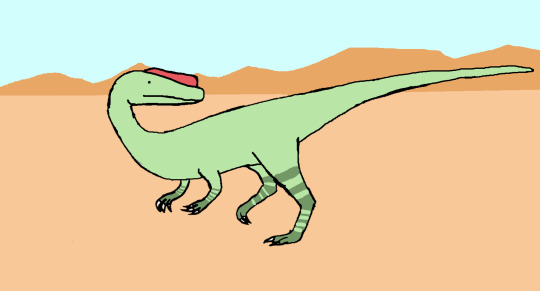
Lophostropheus airelensis
Late Triassic – Early Jurassic (200 Ma)
Things are scary lately, but I hope everyone is doing well. In these stressful times I've taken to drawing dinosaurs on my computer to ease my nerves. Originally, I set out to draw a dromaeosaur, but it somehow ended up a Lophostropheus. But don't worry, I'll do some dromaeosaurs once I'm confident I can draw them as beautifully as they deserve.
Lophostropheus was found in the Triassic-Jurassic boundary in France. Few animals are known to have lived from the end of the Triassic and into the early Jurassic, because this transition was marked by a mass extinction caused, at least in part, by the breaking up of Pangea. Mass extinctions are often recognized because of sudden, dramatic turnovers in the fossil record. We don't expect to see individual genera or species surviving the events, and this is especially true for dinosaurs of the T-J Extinction, which disproportionately impacted terrestrial life. Of course, we know species had to survive these times of hardship, but thanks to the spottiness of the fossil record it's not often we get to see it. I'm realizing this is starting to sound kind of doom and gloom in today's context, so let's talk more about Lophostropheus.
This is a member of the coelophysoids, one of the first prolific groups of theropods. Coelophysoids were, despite being relatively short-lived, a sign of things to come. They were lankier and had smaller heads compared to the more robust earlier theropods, like Herrerasaurids. They also have a lot of traits we associate with later theropods, showing that these features appeared quickly once dinosaurs established themselves. Many were small and slender like the group's namesake, Coelophysis, but some later members, like this one here, got bigger. Lophostropheus isn't known from the best remains, but could have been up to 3 meters (10 feet) long. That may not sound like much, but this put it among the largest carnivorous dinosaurs of the time.
Because Lophostropheus is known from fragmentary remains, it's difficult to say much definitively about its behavior or ecology, and I'll admittedly be inferring based on similar features in related dinosaurs. So, take the next section as you will, but know I'm trying to avoid speculating too hard. As a science communicator, the last thing I want to do is mislead.
Lophostropheus probably preyed on large herbivores, including early sauropodomorphs like Plateosaurus, and may have chased down smaller, more agile animals as well. The function of its crest is unclear. It was too fragile to be used as a weapon or armor, which, to be fair, would be kind of far-fetched anyway. It may have been used for intraspecies interactions, as a mating display or as an intimidation tool against rivals.
It was originally considered a species of the closely-related Liliensternus, but was assigned to its own genus in 2007. In fact, after deciding not to draw a dromaeosaur, I wanted to draw Liliensternus, but found out it didn't have that Dilophosaurus-like crest it's always depicted with. BUT I learned a very similar dinosaur who did have a crest existed, and thus, Lophostropheus. I'm wondering if the trend of Liliensternus being depicted with a crest was caused by this dinosaur being associated with it, but I haven't found anything confirming it.
That's about what I have to say about Lophostropheus. I didn't really know it existed until I drew it, but the Triassic/early Jurassic is one of my favorite time periods of the Mesozoic. It's fascinating how quickly dinosaurs established a foothold, and then how quickly they flourished once they had the space. Even when they looked kind of the same, dinosaurs were starting to show the traits that would become markers of their diversity.
SOURCES
Ezcurra & Cuny 2007 – The coelophysoid Lophostropheus airelensis (Abstract only, I couldn’t access the full paper)
Olsen, Shubin, & Anders 1987 – New Early Jurassic Tetrapod Assemblages Constrain Triassic-Jurassic Tetrapod Extinction Event
******************************************************************************
Buy me a Ko-fi, if you’d like!
#lophostropheus#theropods#dinosaurs#reptiles#triassic#jurassic#mesozoic#paleontology#palaeontology#paleoart#palaeoart#paleoblr#palaeoblr#prehistoric
27 notes
·
View notes
Photo
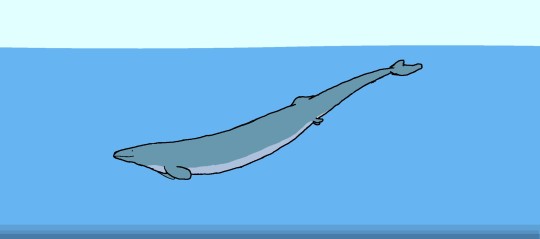
Basilosaurus cetoides
Late Eocene (41-34 Ma)
Bluuughhhhhhh. I forgot the clocks were going to move forward last weekend, and my schedule is completely off-kilter. But after slamming most of a big cup of coffee, I'm here to talk about a really cool whale. The Eocene was a great time to be a mammal. After taking their first shaky steps into the limelight during the Paleocene, mammals took over the world in the Eocene. Whales were among the most immediately successful groups, and Basilosaurus was one of the earliest whales fully adapted for marine life. It had a fusiform body and a powerful fluked tail, with its forelimbs adapted into flippers. They ranged in size from 15-20 meters, making them not only one of the earliest large whales, but possibly the largest animal in the Paleogene period.
It's no secret that I love taxonomy, so let's talk about it!
There are two species of Basilosaurus: The type species, B. cetoides and the slightly smaller B. isis. ‘Basilosaurus’ means ‘King Lizard,’ which is weird because, you know, it’s a whale. It’s called that because its discoverers thought it was some kind of sea serpent thanks to its weird body proportions. After the realization it was a whale, the name Zeuglodon was suggested as a replacement. However, since Basilosaurus was the first name given, it had priority, and Zeuglodon became a junior synonym. It gets wackier. Another junior synonym is Alabamornis. This means 'bird from Alabama,' and was given to what was thought to be a big bird's shoulder bone in 1906, but was actually a pelvis of Basilosaurus. And on the less scientific side of things, in 1845, Dr. Albert Koch unveiled the skeleton of a giant sea serpent he called “Hydrarchos,” which would have been really cool if it wasn't really fake. It was probably two Basilosaurus skeletons stuck together, but we don't know for certain because it was destroyed in 1871 by the great Chicago fire.
Despite looking like a modern whale in many respects, Basilosaurus was still weird. Compared to modern predatory whales, it has a proportionally longer body and neck. Its head was smaller, with no room for a melon (the adorable name for the hearing organ toothed whales have in their foreheads). It had a smaller brain too, and probably wasn’t as social or intelligent as say, an orca. Its flippers also had a functioning elbow joint, like sea lions. It was probably best at swimming in two dimensions near the water’s surface, rather than diving.
Perhaps the strangest thing, though, is its pair of tiny hind limbs and pelvis disconnected from the vertebral column. Some whales today have tiny, vestigial hind limbs, but they're reduced to a few useless bones hidden beneath the skin. Basilosaurus' back legs were recognizable as such, and were used for... something. Maybe holding onto each other while mating, almost certainly not for biking.
This animal was widespread throughout the Tethys sea, the ancient waterway between Gondwana and Laurasia in the Mesozoic. As Africa and Eurasia moved toward each other, it was beginning to split in the Eocene, but it still covered swaths of land in shallow, warm sea. The two species of Basilosaurus have different teeth, and probably fed on different prey. B. cetoides typically ate large fish and sharks. B. isis, though, is known to eat Dorudon, a smaller basilosaurid whale. Specimens of Dorudon have been found with bite marks in the skull, attributed to Basilosaurus, and the damage done to the skeletons around it suggest B. isis hunted by delivering a fatal wound to the head before tearing the body apart with its jaws, which sounds metal as hell.
Basilosaurus has always been a favorite mammal of mine. It has a certain elegance and beauty I've always admired, the first of the cetacean giants. Although I'm not a particularly religious or spiritual person, there's something magical about seeing such a huge animal swimming in open waters. I hope I captured some that mystified feeling with this drawing. I first saw Basilosaurus in the second episode of Walking with Beasts, wherein a pregnant B. isis has to find food at the beginning of a climate crisis. WWB constitutes a good 70% of my Cenozoic knowledge. It probably won't be long before I've drawn every mammal featured in it, and I swear I'm not doing that on purpose. Mammals aren't really my strong suit, especially not whales, but I had a lot of fun drawing this. And part of the point of this blog is to teach myself about groups I otherwise don't really study, so I guess you could say I did a good job of that.
SOURCES
Riley Black, 2009 – The Rise and Fall of Alabamornis
Gingerich, 1998 – Paleobiological Perspectives on Mesonychia, Archaeoceti, and the Origin of Whales
Voss, et al. 2019 – Stomach contents of the archaeocete Basilosaurus isis
******************************************************************************
Buy me a Ko-fi, if you’d like!
#basilosaurus#zeuglodon#whales#cetaceans#mammals#eocene#paleogene#cenozoic#paleoart#palaeoart#paleoblr#palaeoblr#paleontology#palaeontology#prehistoric
29 notes
·
View notes
Photo
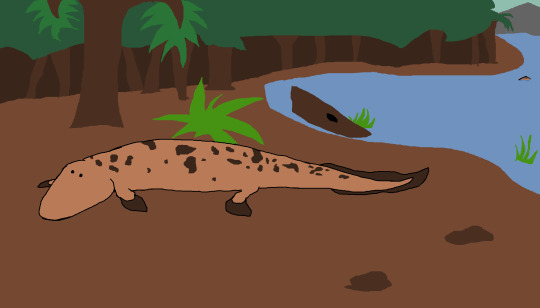
Tiktaalik roseae
Late Devonian (375 Ma)
I'm back again, after a loooong time neglecting this blog. I've been planning to come back for a while, and I'm finally here! I thought I'd return with one of my favorite vertebrate fossils, Tiktaalik roseae! The common ancestor of all tetrapods was probably not Tiktaalik, but something very similar. Scientists use it as a model organism for that ancestor, though, and I'll be doing the same here.
The invasion of the land is a fascinating subject for paleontologists, because it’s one of the first major steps toward life as we know it today. Life evolved in the oceans, and for the majority of earth's history, stayed there. It's uncertain when exactly life first made landfall. Rocks from deep in the Precambrian show evidence of photosynthetic microbes who lived on land, and simple plants were sprouting along shorelines by 430 million years ago. Before this, water on earth was confined to oceans or isolated lakes, but the advent of those land plants meant the creation of the first soils and mud, in turn leading to the formation of the first river systems. Not long after the first terrestrial plants, arthropods and their relatives arrived and began carving niches for themselves.
By the middle Devonian (~385 Ma), terrestrial ecosystems proliferated. The first forests covered the landscape, and invertebrates ran rampant, including the earliest insects. Fish, though, had yet to leave the water. So, what took them so long? Simply put, they waited until they had a good enough reason to go poking around up there. Although the land is my main focus today, the Devonian is more famously known as the Age of Fishes. This was the first time jawed vertebrates rose to the top of their ecosystems, and the first time they got truly big. This was the height of the placoderms, armored fishes like the infamously gigantic Dunkelosteus, and Bothriolepis, which kind of looked like a shield with fins. On the cartilaginous side were the spiny 'sharks,' as well as true sharks like Cladoselache and Stethacanthus.
At this point I'm just naming prehistoric fish that I like, so let's get back to tetrapod evolution.
Most of the traits we associate with tetrapods evolved in fully aquatic fish. Specifically, in a branch of fish called Sarcopterygians, or lobe-finned fish. Today, lobefins are represented by a handful of lungfish and the coelacanth, but they were all over the place in the Devonian. Early ancestral cousins of tetrapods were animals like Eusthenopteron, which looked like ordinary fish on the surface, but had unique skeletal structures. Particularly, their pectoral fins are built similarly to tetrapod limbs. Later animals would develop larger, sturdier fins they used for walking along the bottom of rivers, rather than land.
This is where our star comes in. Tiktaalik was adapted to live in shallow rivers or streams. It had a wider, flatter body than most fish, and it had lost its dorsal and anal fins. The four fins on its underside were built very similarly to tetrapod limbs. Tiktaalik is also one of the first vertebrates with a proper neck, meaning, in the words of Will and David from The Common Descent Podcast, you could strangle it, if you ever wanted to do that sort of thing.
Tiktaalik was a predator of small-to-medium-sized invertebrates. Its big, triangular head housed pointy teeth, and had two eyes on top. It looked like a crocodile in many ways, and may be one of the earliest animals to adapt the crocodilian lifestyle, laying at the bottom of a body of water and waiting for prey to come by. The placement of Tiktaalik's eyes may have been useful for peering out from the water surface while staying mostly hidden.
Despite being known as the 'fish with feet,' Tiktaalik wasn't exactly graceful on land. Rather than walking primarily with limb muscles like most tetrapods do, Tiktaalik walked by heaving itself forward with its front limbs and powerful shoulder muscles. Basically, it walked by doing push-ups. As you can imagine, Tiktaalik probably didn't spend much time out of the water. But, this goofy style of terrestrial movement was a precursor to the more efficient methods seen in landlubbers today.
Tiktaalik is my favorite prehistoric fish, and definitely a contender for favorite vertebrate. It was one of the first animals to really grab my attention once I started seriously getting into paleontology. While I was still trying to understand evolution I read Your Inner Fish, a book written by Neil Shubin, who was a part of the expedition team who discovered Tiktaalik. It discusses the animal in so much more detail than I did here, and is pretty much required reading for anyone who's interested in paleontology. In fact, I'm gonna go ahead and say it is required reading. If you haven't already, get on it. I promise you’ll love it.
Oh, and another reason I like Tiktaalik is because it's so charming. I don't think we could have asked for a cuter, goofier-looking fishapod. The image of it flopping around on land is both hilarious and really, really interesting to me. One day I want to commission a beautiful oil painting portrait of Tiktaalik like rich people do with their dogs.
That’s about it for this post! I hope I’m not too rusty. I can’t promise a daily post anymore, but I want to post at least semi-regularly.
SOURCES (this is also something I want to start doing btw):
Battistuzzi, Feijao, and Hedges 2004 - A genomic timescale of prokaryote evolution
Shubin, Daeschler, and Jenkins Jr. 2014 - Pelvic girdle and fin of Tiktaalik
The origin of tetrapods - Understanding Evolution
The Common Descent Podcast Ep. 77 - Fins to Feet: The Fish-Tetrapod Transition
Your Inner Fish, Neil Shubin
******************************************************************************
Buy me a Ko-fi, if you’d like!
#tiktaalik#lobe finned fish#sarcopterygii#fish#tetrapods#devonian#paleozoic#paleoart#palaeoart#paleontology#palaeontology#paleoblr#palaeoblr#prehistoric#*plap* *plap* *plap*
49 notes
·
View notes
Photo
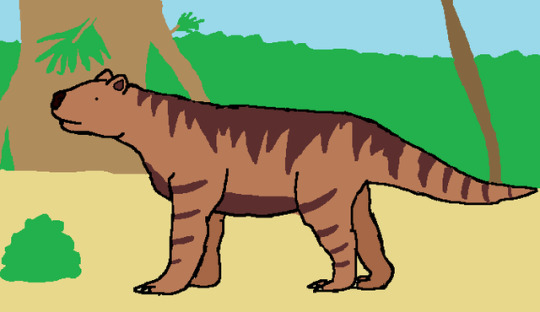
Thylacoleo carnifex – Early-late Pleistocene (1.6-0.46 Ma)
It’s been a long and very unannounced hiatus, but today is the day it ends. I’ve been extremely busy, but now I’m not. In the meantime, I learned about a fascinating little Australian named Thylacoleo carnifex. It’s commonly known as the marsupial lion, but is a lion in the same way a sea lion is. That is to say, it can hardly be considered a lion at all. It is a marsupial, though, and a member of the same order as kangaroos, koalas, and wombats. There are three total species of Thylacoleo, but T. carnifex is the best understood and most well-known, so I’ll talk about that one.
Australia has been disconnected from every other continent for more than 80 million years, splitting from Antarctica during the Late Cretaceous. During most of the Age of Mammals, metropolitan groups of mammals like cats, rodents, and ungulates (hoofed mammals), were unable to reach it. As a result, the marsupials and monotremes who were already there took over, and things got weird.
Thylacoleo lived during the Ice Age, but isn’t typically what we think of when it comes to Ice Age animals. Australia didn’t witness the huge ice sheets seen in North America and Eurasia, but colder worldwide climates meant Australia’s iconic outback was covered in temperate forests. Thylacoleo lived here. At roughly the size of a small tiger, it was the largest carnivorous mammal to ever live in Australia. It’s shaped roughly like the big cats dominating the rest of the Pleistocene world. This isn’t the only example of convergent evolution with Australian mammals. Palorchestes was another giant marsupial that evolved into something that looked like a tapir. In fact, certain body shapes pop up again and again among isolated ecosystems. Apparently, there is an optimal body plan when it comes to fulfilling certain roles.
But Thylacoleo has a few key differences from its distant feline cousins, and these give clues about its lifestyle. It had a stocky body and big, powerful forelimbs, along with a thick tail. It wasn’t chasing down prey at all, and was probably an ambush hunter that wrestled prey with its front limbs, using its tail for balance. Weirdly enough, it has a lot in common with Smilodon, the saber-tooth cat. Evolution really do be like that sometimes. But there’s something else about this animal, something best explained by showing you. So, now’s the part of the show where it sings us a soulful ballad and—

GOOD LORD WHAT IS HAPPENING IN THERE?
Now, mammals are famous for having weird teeth. Mammal teeth are weird enough that a whole lot of fossil mammals are… just teeth. But Thylacoleo is special. Its incisors were sharpened, acting like the canine teeth of other predatory mammals. Those big rectangular teeth acted like scissor blades for cutting meat and bone. They’re (very) elongated versions of teeth called carnassials. Most carnivorous mammals have a less wild version. If you look inside your dog’s mouth, they’re the two pairs of big, pointed teeth towards the back of their mouths. Cats have them too, but they’re a lot less pronounced.
Having weird-ass teeth like this means their hunting strategy was a little unorthodox. Big cats hunt by sinking their fangs into the neck of their prey, blocking its windpipe until it suffocates. Woof. Thylacoleo couldn’t really do that, thanks to its carnassials. Thylacoleo hunted its prey by crushing the windpipe and spinal cord of its prey with those mouth blades. It also had the strongest relative bite force of any mammal we know of, so it was pretty good at what it did.
So, what happened to the marsupial lion? It went extinct around 50,000 years ago, along with a lot of the other Australian megafauna. That’s probably not a coincidence. Thylacoleo was fantastic at bringing down large prey, but very poorly-adapted to hunting smaller animals. Such heavily specialized animals are often the first to go in extinction events. The Australian climate was beginning to shift as well, beginning to resemble modern Australia. This brought with it all the calamities, big and small, of climate change. Oh, and humans showed up around 60,000 years ago. There is evidence of interaction between Thylacoleo and Aboriginal Australians, in the form of cave paintings of a pouched carnivore. Aboriginal tradition also describes monsters and animals that may have been inspired by Thylacoleo. Methods of farming used by ancient humans may have further destroyed the forests Thylacoleo depended on for hunting, as well.
Thylacoleo is essential to understanding Ice Age Australia. It lived in an ecosystem that doesn’t really exist there anymore, and was specialized in hunting prey that mostly perished alongside it. It showcases both sides of island evolution: The unique traits, as well as the convergent ones. Its extinction marked the end of an era, one dominated by marsupials since the wake of the K-Pg impact event. Australia is still unique today, but there still isn’t a predator around quite like this one.
******************************************************************************
Buy me a Coffee, if you’d like!
#thylacoleo#marsupial lion#marsupials#mammals#pleistocene#ice age#cenozoic#paleoart#palaeoart#paleoblr#palaeoblr#paleontology#palaeontology#prehistoric#australia
206 notes
·
View notes
Photo
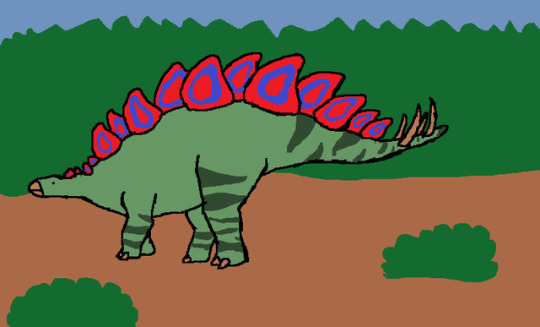
Stegosaurus – Late Jurassic (155-150 Ma)
Y’all like dinosaurs?
Me too, and in an effort to talk about the more popular groups, today’s subject is Stegosaurus, the covered lizard himself. Stegosaurus is a staple of pop culture depictions of dinosaurs. Everyone who knows anything about dinosaurs knows Stegosaurus, and most of those people love it. The people who don’t aren’t worth listening to, in my opinion. Stegosaurus is a fascinating animal for a million reasons, but I’m going to try and narrow it down to my favorites.
Part of Stegosaurus’ reputation comes from how striking and easily-recognized it is. The deep, narrow torso, plates, and 3 foot long (!!!) tail spikes are immediately indicative that the animal you’re looking at is a Stegosaurus or something close to it. Even by dinosaur standards, this is an unusual body plan unique to the Stegosaurus family, and these traits have been endlessly scrutinized in an effort to understand what they were for. The plates were tall and flat, arranged in an alternating pattern on its back and numbering anywhere from 17 to 22. Well-preserved Stegosaurus plates are etched with branching grooves. Othniel Charles Marsh, the legendary paleontologist who discovered Stegosaurus, thought they were used as armor. But, the lack of coverage and overall fragility of the plates leads us to think they weren’t used for defensive purposes, but for display. The grooves housing blood vessels that could be flushed, reddening the thin layer of skin covering them. This could be used either as a mating display or as a warning to any predator trying to fuck with it.
The four parallel spikes on a Stegosaurus’ tail are informally called the “thagomizer,” named after a joke in a Far Side strip. It’s worth mentioning that this isn’t just a pop culture thing—scientists love calling it that. The thagomizer was a weapon, and a formidable one. Most big dinosaurs had hardened tendons in their tails, making them stiff and ideal for balancing their large bodies. Stegosaurus didn’t have these tendons, making its tail much more flexible than that of the average herbivore. It compensated with a sloping posture, with shorter forelimbs and long, thick hind limbs. These proportions aided in swinging its tail, allowing it to anchor itself with the back legs while pushing off with the front, giving the swing lots of power. Many preserved spikes have evidence of impact trauma, and an Allosaurus has even been found with punctures in the bone. As it happens, Stegosaurus spikes happen to fit perfectly into these punctures. So, unless the Allosaurus in question just kind of fell sideways onto a dead Stegosaurus or something, this all points to a weaponized tail. If it’s good enough for forensic scientists, it’s good enough for rockbonologists.
Is the idea that Stegosaurus had two brains still a thing? It was a thing when I was a kid, but I’m not sure if it’s fallen out of favor or not. This was something proposed by Marsh when he first described Stegosaurus, as an explanation for the big cavity in its hip region. Because Stegosaurus’ brain is so tiny, reasoned Marsh, a secondary brain in the hips added extra processing power. The problem is, this cavity isn’t unique to Stegosaurus—sauropods had it, as do a certain group of dinosaurs called birds. Now, in birds, the organ filling this space is a part of the spinal cord. It’s not a brain at all, but something called a glycogen body. This should be an easy win for us. If this organ is present in living animals, it was probably there for the related Stegosaurus too, and it probably did the same thing. That brings us to problem 2: Nobody knows what exactly glycogen bodies do in birds. They’re made of cells rich in glycogen, a vital sugar used for storing energy. Despite this, the glycogen body seems unrelated to normal glycogen functions, and is, essentially, a big question mark.
While we’re on the subject of brains, a lot of people think dinosaurs were stupid, and a lot of that comes from studies of Stegosaurus’ brain case, which was super tiny. Only the upper-back corner of the skull was devoted to brain room. That being said, stop calling Stegosaurus stupid—it’s mean and he doesn’t deserve it. He had a tiny walnut brain, sure, but his brain was just the size he needed it to be to eat shrubs and swing his tail around. Herbivores, on the whole, don’t need to be quite as intelligent as carnivores, and Stegosaurus was good at what it did.
Also, nobody knows exactly how Stegosaurus had sex. Think about it.
******************************************************************************
Buy me a Coffee, if you’d like!
#stegosaurus#thyreophora#ornithischians#dinosaurs#reptiles#jurassic#mesozoic#paleoart#palaeoart#paleoblr#palaeoblr#paleontology#palaeontology#prehistoric#please be nice to him he's not stupid
73 notes
·
View notes
Photo
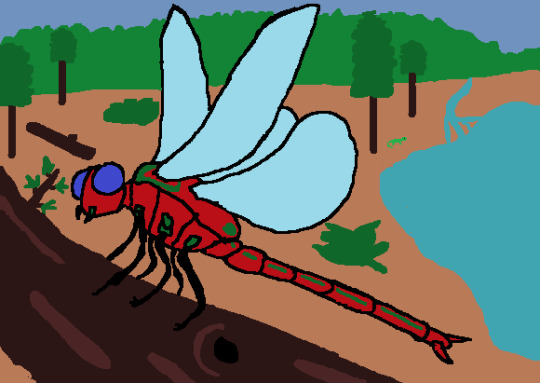
Meganeura – Late Carboniferous (305-299 Ma)
Remember a while ago, when I talked about big Carboniferous arthropods, and then proceeded to talk about a tiny one? And then at the end, promised to talk about the big ones ‘soon’? Well, it’s finally time. This is one of my favorite insects of all time, and one that was really, really fun to draw.
Meganeura, (‘large nerve,’) was one of the biggest flying insects ever. Its wingspan ranged from 25-28 inches (65-70 centimeters). This is an insect the size of a crow, as David from the Common Descent Podcast put it. It’s a member of a clade called Meganisoptera, or griffinflies, and are closely-related to dragonflies and mayflies. Meganeura is an unusually well-preserved insect. Its name comes from the fact that several of its fossils clearly shows the veins of its wings. This is what we paleoinvertebrate enthusiasts call a Big Deal™. And look at the detail of those segments, and even the head, which is unusual for Meganisopteran fossils.
I discussed this the last time I talked about a Carboniferous arthropod, but the Carboniferous and very early Permian are the only time insects got this huge. Afterwards, they never got quite this big again. That’s likely because the Carboniferous atmosphere contained around 33% oxygen content, whereas now it’s only 21%. Arthropods have no lungs. Air flows through openings in their body called spiracles, and is then carried through their respiratory system and distributed through the body directly. The movement of the different segments of their body also helps move oxygen. They don’t inhale or exhale, and they don’t have blood as we know it. It doesn’t carry oxygen, and functions more like our lymphatic fluid.
If this sounds dumb and impractical, it’s actually way more efficient for small animals. It’s a lot less effort than active respiration. Small vertebrates are always breathing so quickly, but arthropods are just fine. The downside is, they can only get so big, since they need a certain amount of ambient oxygen or they just can’t breathe. But the Carboniferous offered exactly that, and thusly, we have monstrosities like Meganeura and its pals.
There is some controversy to this idea, though. Similarly-sized Meganisopterans lived into the Permian, when the oxygen content appears to be much closer to that of today. Scientists also point to a lack of flying vertebrates, giving insects license to party in the sky.
This was a predatory insect, if ever there was one. It ate other insects for the most part, but also ate small amphibians and reptiles if it could get ahold of them. The key phrase there is, “if it could get ahold of them.” Although its living cousins are speedy little fighter jets who can quickly zip and weave, Meganeura was a slower, more powerful ambush hunter. Its eyes were similar in shape to those of modern Hawker dragonflies, which hunt by watching the air overhead and leaping from its perch to snatch flying prey. They were adapted more for hunting in open areas, rather than the dense undergrowth so characteristic of the Carboniferous.
These wings were powerful—modern dragonflies and mayflies fly with what’s called direct flight. This means they have muscles attached directly to their wings, whereas plenty of other insects fly by flexing their bodies to indirectly move their wings. Meganeura probably moved its wings like dragonflies, and that probably allowed it to get so big while retaining its flight and lifestyle. We don’t know for sure how quickly it beat its wings, but they may have sounded something like this.
In summary, this was an insect that acted a lot like a dragonfly, only gigantic. It was a dragonfly that could eat lizards, and whose nymphs were active hunters of small fish and amphibians. This backwards world, where bugs eat fish and are the biggest terrestrial organisms, is part of what makes paleontology so exciting. Everything about Meganeura reads like a description of a sci-fi monster. This is a huge part of why I love the Paleozoic so much, too. It was the slow windup to modern conventions and ecosystems, and in the meantime, pretty much anything went. Bugs could be giant apex predators, and that was just fine.
Also, I did base its color scheme off Yanma and Yanmega, which are two of my favorite Pokemon.
******************************************************************************
Buy me a Coffee, if you’d like!
#meganeura#insects#arthropods#invertebrates#carboniferous#paleozoic#paleoart#palaeoart#paleoblr#palaeoblr#paleontology#palaeontology#prehistoric#bzzzzzzzzzzzzz
49 notes
·
View notes
Photo
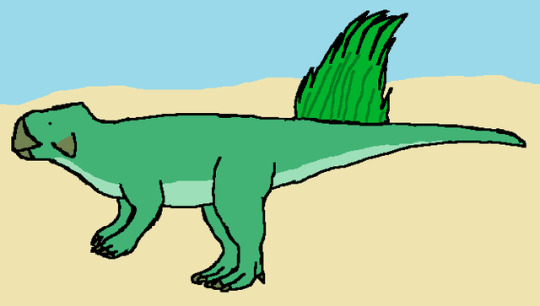
Psittacosaurus – Early Cretaceous (126-101 Ma)
I’m a mess. I’ve been running this blog for a long time, and I barely talk about dinosaurs. I was thinking about the dinosaurs I’ve drawn, and I haven’t even covered most of the famous groups, including ceratopsians. Mess.
So let’s talk about a ceratopsian. Ceratopsians were the dinosaurs who looked like Triceratops; frill, facial horns, beak, etc. This little guy is named Psittacosaurus, which means “parrot lizard.” It was about the size of a golden retriever, and was a more basal sort of ceratopsian. It has no frill, only a ridge on the back of the skull. It had two spikes on its cheeks—one species even has horns protruding from the front of the skull, but it’s likely convergent evolution, not a directly ancestral trait for future ceratopsians. It was still a biped, though, even as an adult. Its remains are found in eastern Asia, from Russia, China, and famously, Mongolia. We’ve found hundreds of fossils of 11 different species and from all stages of life. This is one of the dinosaurs we have an almost complete image of.
Psittacosaurus was an efficient little herbivore, with a tough beak and a battery of self-sharpening teeth. Desert plants tend to be hardier and thicker, and these teeth let it slice through those tough desert plants without a problem. It also swallowed stones to aid the digestion process. This is a behavior seen in many herbivores today. Plants are kind of hard to digest, so plenty of animals swallow rocks to help grind up their food. Psittacosaurus had big eyes and, surprisingly, a pretty big brain. They built nests and took care of their hatchlings. They were probably comparable to a sparrow in terms of intelligence, which is a reminder that despite popular thought, dinosaurs weren’t stupid.
Speaking of bipedalism, this animal has kind of a weird relationship with the concept of walking on two legs. Its young may have been quadrupedal, suggesting it evolved from a quadrupedal ancestor. So, this means one of two things: 1) Ceratopsians evolved from quadrupeds, became bipeds, and then went back to walking on all fours, or 2) This is a more derived ceratopsian that branched off from the line leading to the big guys from later on. The former isn’t as wacky as it sounds—other animals have done it in their history. The latter is just as likely, though. This sort of thing is really hard to determine in animals who are a hundred million years old.
Unlike its descendants, Psittacosaurus was agile and quick on its feet. Later ceratopsians were more like tank builds. When something wanted to eat a Triceratops or its babies, it’d hunker down and wave its horns and frill and warn the predator to piss off. But in Psittacosaurus’ case, it was the one doing the pissing off. It was small, so it makes sense that it would want to run away instead of trying to fight. We’ve also learned, through molecular studies, that its skin was countershaded. Countershading is a type of camouflage common in a lot of animals, where the top half of its body is dark, and its belly is lighter. This makes it harder to see them by messing with their shading. Deer, dolphins, and manta rays are some of the many animals that do this today. Psittacosaurus likely depended on this to avoid being spotted by theropods, who hunted primarily with eyesight.
Another cool thing we learned about this guy fairly recently is the brush of quills on its tail. Now, this is kind of weird for a few reasons. Dinosaurs are divided into two big groups, Ornithischia and Saurischia. Birds originated in Saurischia, and many, many Saurischians had feathers. The exception is sauropods, although they might have had quills on their back. It makes sense to think that feathers originated in this branch.
BUUUUUUUUUUUT
A few groups of Ornithischians had quills, like Psittacosaurus. So, it’s been proposed that feathers are an ancestral trait for all dinosaurs, and that the most recent common ancestor of all of them was at least fuzzy. Although, the quills in Psittacosaurus were different from those of their distant birdlike cousins. They had a conelike structure and might have been filled with some sort of fluid. They may have even been covered in keratin, making them quite different from what we usually call ‘feathers.’ They’re also only found on a very particular and unusual part of the body. The most convincing study on these weird quill things has concluded that they aren’t really similar enough to be considered homologous to theropod feathers, and probably evolved independently. Mind you, we don’t know for sure, and fuzzy Coelophysis isn’t completely unreasonable. Given sauropods may have had quills, maybe those were the ancestral structure, and theropods just went buckwild with them.
Also, this means Triceratops may have had a sparse smattering of quills on its butt, which I like a lot. I’ll draw a bigger ceratopsian with quills at some point and it’ll be a fun time.
One more thing about Psittacosaurus, and it’s not really particularly scientific, but this thing is SO CUTE. I want one as a pet. Maybe it would be kinda spiky, and maybe it wouldn’t be great for petting, but I think it would be a good friend.
That’s all for today’s animal, a dinosaur whom I love very much. I think from now on, I will make more of an effort to draw more famous dinosaurs, because a lot of them are well-known and I like a lot of them. I just don’t want to get it all out of my system at once, you know?
******************************************************************************
Buy me a Coffee, if you’d like!
#psittacosaurus#ceratopsians#ornithischians#dinosaurs#cretaceous#mesozoic#paleoart#palaeoart#paleoblr#palaeoblr#paleontology#palaeontology#prehistoric#my very good parrot-faced friend
40 notes
·
View notes
Photo
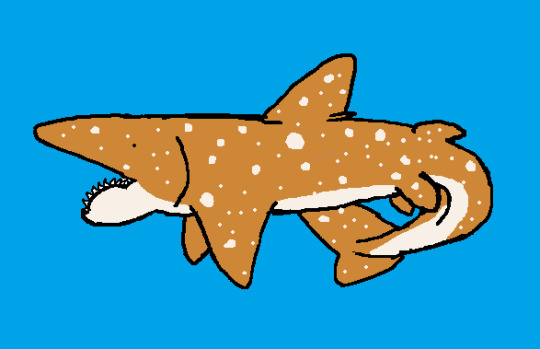
Helicoprion- Middle Permian (290 Ma)
For someone who loves fish as much as I do, I rarely talk about them here. This is only the third fish I’ve drawn for this blog, and this one wasn’t even my idea. This animal was requested by @mrultra100, who also suggested the color scheme! This one was really fun to research and pretty challenging to draw (in a good way), so thanks for the suggestion! This was a widespread, cartilaginous fish found on every major continent except Africa and Antarctica. This was prime Pangea time, so there was really only one ocean anyway, the Panthalassa. Even though it looks like a shark, it belongs to an extinct order called Eugeneodontida, whose closest living relatives are chimaeras. That’s why the color scheme is based on the spotted ratfish.
The most famous and immediately different feature of Helicoprion is the tooth whorl in the lower jaw. Almost all Helicoprion fossils consist of only these swirly teeth, and a lot of what we know about its appearance is based on its relationship with ratfish and an extinct cousin called Ornithoprion. Since there’s absolutely nothing else with a sharp swirly thing on it alive today, it took a long time to figure out what we were looking at when we dug them up. In the past, it’s been suggested as:
- A part of the upper jaw, curling up over the snout.
- The end of the tail, normally curled but could be lashed at predators.
- A really weird dorsal fin as some kind of defense. Not a very good one, but still.
- The lower jaw, curled downward out of its mouth.
The last interpretation was considered correct for a long time, until partial remains in 2013 revealed it was contained entirely in its jaw. This version looks really really cool and I almost considered drawing it like that instead, but that would be a betrayal of my mission statement, I think. On the plus side, that means this was a much bigger animal than we thought. We have no direct evidence of the shape of its body, but if our estimates are right, it could have been up to 30 feet long. That’s bigger than any non-filter feeding shark alive today.
Since we don’t really know what the whole fish looked like, we can only guess what it used the tooth whorl for, exactly. We know that teeth would grow on the end towards the throat, pushing older teeth into the spiral. We think these were the only teeth in its mouth, and that it used this line of teeth to crush prey against the roof of its mouth. Back when we thought things had to go extinct for a reason, we thought Helicoprion died out because the tooth whorl was too unwieldy. Even though this theory was unpopular long before we knew where exactly the whorl was, knowing that it’s definitely inside its mouth completely discredits the idea that it was too clumsy.
Everything we know for sure about Helicoprion shows how jury-rigged every living animal on earth is. The spiral of constantly growing teeth sounds absolutely ridiculous, especially compared to modern cartilaginous fish whose teeth are arranged like we’re used to, and just replace themselves when they fall out. The tooth whorl evolved in Helicoprion because, well, it was clearly doing something useful for it. There are other, seemingly more straightforward ways to go about crushing things with your jaws, but this lineage just happened to have a string of circumstances (or lack of circumstances) leading to the infamous swirly mouth. We can’t say for sure why that is. Natural selection is complicated, and not everything evolves because it helps something survive. Plenty of traits evolve because there’s no pressure against that trait. Other traits evolve because of the mating preferences of female members of a species. There are a lot of potential reasons for the tooth whorl, but something as unusual and derived as this likely evolved because it served a good purpose.
That’s about it for this mysterious fish. I hope I did a good job, it’s not every day I get a recommendation, and I wanted to go all-out! I did what I could with our limited understanding.
******************************************************************************
Buy me a Coffee, if you’d like!
#helicoprion#fish#permian#paleozoic#paleoblr#palaeoblr#paleoart#palaeoart#paleontology#palaeontology#prehistoric#requests
127 notes
·
View notes
Photo
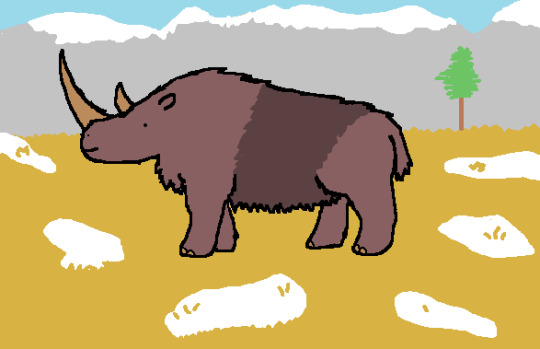
Woolly Rhinoceros – Late Pliocene-Late Pleistocene (3.6-0.01 Ma)
We’re getting iconic again, and talking about yet another ice age megafauna. This is the woolly rhinoceros, the best rhino ever. It might seem like a pretty basic animal, just a fluffy rhino. But, like most of the big ice age mammals, we have a comprehensive knowledge of this animal, from its appearance to its lifestyle to even its genetics.
Like with the mastodon, ‘woolly rhinoceros’ is a common name. Its scientific name is Coelodonta antiquitatis, which means ‘old hollow tooth.’ If that sounds kind of bland, that’s because it was named in 1807, and was one of the first extinct animals described, although it had been known as the woolly rhinoceros for a while before being formally named. Woolly rhinos evolved on the Tibetan plateau at the end of the Pliocene. When the Pleistocene began and the earth grew colder, woolly rhinos spread, migrating all across Eurasia. They were the most widespread and successful species of rhinoceros to ever live, and their remains are pretty common. Along with a lot of skeletal remains, a few frozen specimens have been found in Siberia, with flesh and even fur intact. Because of that, we’ve been able to study their DNA and learn that their closest living relative is the Sumatran rhino.
Like the rhinos we know, love, and desperately try to protect today, these boys had horns. Two of them. One really big one on the tip of the snout, and a smaller one between the eyes. When these horns were first discovered, they were thought to be the talons of a giant bird, but now we know they belonged to a rhino adapted to life in the cold. The horns were used the same way any rhino uses its horn, for defense and as a mating display, but also used them to clear snow from the ground as they looked for something to eat. They were mostly solitary animals, although they sometimes traveled in groups of a few individuals.
Although they sported thick, shaggy pelts and other adaptations for the cold, woolly rhinos were perfectly capable of living in warmer climates, and didn’t die off because the earth got warmer, like we previously thought. They were generalist herbivores, and while their populations were certainly affected by the end of the ice age, many of them carried on business as usual. While it’s hard to say what exactly drove a prehistoric animal to extinction, generally, we think human hunters are to blame. They valued woolly rhinos for their meat and thick pelts, and since early humans had no idea about abstract ecological concepts like extinction, they probably hunted them until they stopped finding them.
It kind of sucks that here we are, thousands of years later, still killing all the rhinos. Except now we just kind of do it for fun, and we really should know better.
I mentioned woolly rhino DNA, and there’s more to say about that. Just before woolly rhinos went extinct, there’s evidence for a genetic bottleneck. A genetic bottleneck (also called a population bottleneck) happens when a population is heavily reduced, leaving only a few members. This cuts down the genetic diversity down accordingly. Genetic diversity is the key to survival of a species, and in a bottleneck situation, this diversity is limited. This makes it more difficult for the population to adapt, making them more vulnerable to extinction. Small population size often leads to inbreeding in severe bottleneck scenarios, which causes negative mutations. These mutations can’t be selected against, because there are no genetic alternatives, and eventually can pile up until the population spirals to extinction.
That being said, bottlenecks aren’t necessarily a death sentence for a population. Several other animals have been able to bounce back from them in the past. That includes our own Australopithecine ancestors about 2 million years ago, and it’s been suggested Homo erectus experienced one or two as well. There are still repercussions to such an event, though. Diversity builds up very slowly, and it can take a long, long time to recover even a fraction of that former diversity. Case in point, humans are still experiencing aftershocks of our ancestral bottleneck. As a species, we have infamously low genetic diversity, to the point that there are several other subspecies with more diversity than all of the human genome put together.
Only tangentially related, but this is why eugenics is an inherently unevolutionary idea. The ideal of the "master race" calls for the elimination of every single other characteristic, thus shrinking our already minuscule gene pool. All this would do is make Homo sapiens significantly weaker, especially in the long-run.
Back to our friend the woolly rhino, there’s evidence for a bottleneck in their history. Many specimens from just before the woolly rhino went extinct share an unusual feature. Their last neck vertebra has a pair of holes where ribs would fit. The genes responsible for cervical ribs are also linked with juvenile leukemia and a host of birth defects. A combination of overhunting and the recession of ice age glaciers likely shrank their populations, and if our ancestors didn’t finish them off, the rampant diseas and birth defects likely did. We’ve seen a similar pattern in mammoths, too.
I swear, I’m going to say everything there is to say about mammoths before I even get around to drawing one.
On a more charming note, Woolly rhinos were a popular subject of cave paintings. These works of art have been found all along their range, most famously in the Chauvet cave in France. In a lot of these paintings, the rhinos are shown with a band of dark fur on their midsection. I decided to take some advice from my forebears and add that to my own drawing. Thousands of years later, and we’re still here, painting woolly rhinos. Except I’m doing it on a computer and there’s a lot more guesswork involved.
Woolly rhinos are one of the most iconic prehistoric mammals, and have appeared in all sorts of media. If you’re a paleontology enthusiast, I probably don’t even need to tell you where you’ve seen one. For me, the first thing that comes to mind is the sixth episode of Walking with Beasts, “Mammoth Journey.” Beasts really was the passion project of the Walking with team, and it really shows in the finale. It’s a beautiful snapshot of Pleistocene life, with our own ancestors playing second fiddle to a herd of mammoths. Like with the rest of the Walking with series, the CGI and some of the science hasn’t aged perfectly, but a documentary has yet to match it in aesthetic presentation, if you ask me. It simultaneously feels like the falling of the last curtain on prehistory, and the prologue to our own story. Even though the woolly rhino is only a minor player in the episode, it left a lasting impression on me as a kid, and I spent a lot of time drawing them when I was supposed to be paying attention in school.
While I could probably gush about Walking with Beasts for another few hundred words, it’s late, and I’m going to close off the post before it gets too off-topic.
P.S. I can’t promise that every drawing will have a background now, I drew this guy a little on the small side and wanted to spice the drawing up a little bit. The backgrounds are definitely fun to draw, though...
******************************************************************************
Buy me a Coffee, if you’d like!
#woolly rhinoceros#woolly rhino#coelodonta#rhinos#perissodactyls#ice age#pliocene#pleistocene#neogene#quaternary#cenozoic#mammals#paleoart#palaeoart#paleoblr#palaeoblr#paleontology#palaeontology#prehistoric
46 notes
·
View notes
Photo
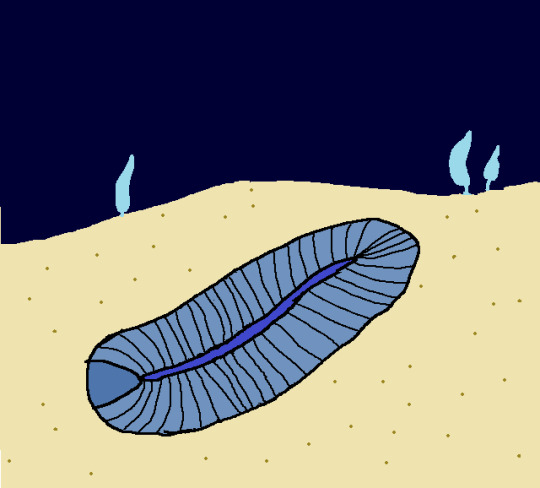
Dickinsonia – Late Ediacaran (558-555 Ma)
I may have been a little too quick to declare the end of my hiatus… But don’t worry, because I’ve got a lot to say about our featured organism today. We’re going back to the Ediacaran to talk about one of my favorite fossils of all time, called Dickinsonia. Its shape is a bit simplistic, so I gave it a little background, with some Charnia guest stars.
Like I mentioned last time, the Ediacaran biota are a loose group of super-ancient organisms who existed before the Cambrian Period, at the very end of the Proterozoic Eon. These are widely considered to be the first multicellular organisms, and lived during the second half of the Ediacaran period, in a span of about 40 million years. Many of these fossils come from the Flinders mountain range in Australia, where their squishy forms were preserved in exquisite detail, though they’re known from other locales too, like Newfoundland, the Ukraine, and England. These fossils are abundant just about wherever Ediacaran rocks can be found, which is really strange considering this was before the evolution of any hardened organic structures. Consider also that younger fossil beds like the Burgess Shale exist because something lucky happened to preserve everything. The Ediacaran biota are just kind of there. Why are there so many squishy organisms fossilized, and why in such detail? The most likely answer has to do with one of the hallmarks of this alien past.
The seafloor of the Ediacaran period was caked in squishy, lumpy carpets of bacteria or archaea feasting on the chemicals around them. These communities of microorganisms are called microbial mats, and although they were almost universal back then, they’re rare today. This is probably because animals who are really good at eating them evolved. If a microbial mat were to form in the middle of a busy reef, it wouldn’t be long at all before some fish or arthropod or something said, “Oh dunk, free food!” and ate it. That being said, they still thrive in remote waters that lack those predators.
So, the best explanation for the preservation of the Ediacaran biota are these microbial mats. They didn’t eat organic matter, so if something big died and sunk into the mat, the microbes covering it would unwittingly protect its impression from being covered by sand. Add a nice layer of sediment and several thousand years, and boom. Those softboys are preserved until subduction destroys the rocks forever.
So, anyway. What’s a Dickinsonia? Some sort of sea pancake? One of the trademarks of the Ediacaran biota is that we really have no clue what we’re looking at. Currently, their fossils are sorted into groups called morphotypes. A morphotype isn’t a real taxonomic division, but a method where organisms are grouped together based on their shape. So, you’ve got circles, and you’ve got fronds, basically. That doesn’t really mean anything though, because I could put snakes, caecilians, eels, and earthworms into the same morphotype—which I call Noodlemorpha—even though they’re all only distantly-related to each other. We just know that little about the lifeforms of the Ediacaran. Put all of that aside for a minute though, because Dickinsonia is special in that we actually know what it is, as of last year. After decades of postulating and debating, a conclusion has been reached. Dickinsonia is...
a bilateral animal.
Yeah, sorry, that’s it. We can’t really say anything else for sure. Still, that’s huge in the context of these organisms, most of which are so weird a new kingdom has been seriously proposed, called Vendozoa. To be able to identify one of them as anything definite is a huge landmark for the scientists who study these fossils.
Dickinsonia lived on the seafloor. It crept along ever-so-slowly, and sifting food out of the sand and leaving trails of circular holes in the microbial mats beneath it. The segments on its body are called isomers, and might have been filled with organic fluids. t would have been very soft and flexible, like a segmented water balloon, but a bit thicker. It didn’t really have to be all that durable considering there wasn’t anything around to attack it. Some fossils even show impressions of possible muscle fibers, and a vein-like structure inside of its body, which some scientists have interpreted as a basal digestive system. It looked something like this, with the internal structure in red:
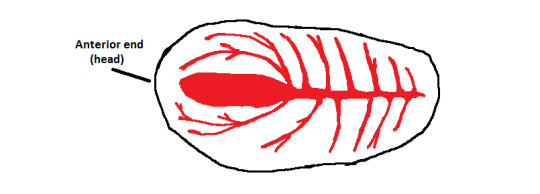
I really, really wanted to link to one of these fossils, but I wasn’t able to find any good pictures of the actual specimens. I can’t stress enough how absolutely extraordinary it is that a fossil this old might still show the internal organs of the thing that left it behind. We can guess a lot about the internal organs of things like dinosaurs based on similar animals alive today, but we’d have absolutely no idea what Dickinsonia looked like under the hood without these surprisingly detailed fossils.
Newly-born Dickinsonia looked like little circular pills without any isomers. We aren’t even close to ready to asking how this thing reproduced, by the way. Maybe it was like a sponge and just kind of spat its business into the sea and hoped for the best, but we have absolutely no idea. As the animal aged, new isomers grew from its posterior end, elongating its body. It grew throughout its entire life, getting bigger and bigger until something killed it. Because of this, they could grow up to 4 and a half feet long (1.4 m). I love marine invertebrates with all my heart, but if I were wading in the ocean and I saw a huge, segmented flapjack sucking nutrients out of the sand, I’d be terrified.
So this very weird oval is, more or less, the pre-alpha version of a multicellular animal. It does everything an animal does, but barely. It moves really slowly and eats other organic matter. It grows in that animal fashion. Despite how little we know about Dickinsonia, it’s one of the most well-understood Ediacaran organisms. It paints a vivid picture of life before the Cambrian, and that picture, as it turns out, is unlike anything we could have guessed. Because of that, and because I hope to study the Ediacaran biota myself one day, Dickinsonia has a special place in my heart.
Before I go, I wanna apologize again for the gap in posts after the alleged end of my hiatus. I’m gonna go back to posting more regularly. Also, while I have your attention, thank you so much to the person who donated to me last week! I’m currently stuck in PayPal Hell, but I will get it eventually, and I appreciate it so so much!
******************************************************************************
Buy me a Coffee, if you’d like!
#dickinsonia#bilateria#invertebrates#ediacaran biota#ediacaran#neoproterozoic#proterozoic#precambrian#paleoart#palaeoart#paleoblr#palaeoblr#paleontology#palaeontology#prehistoric#i had so much fun with this one#and thank you again to the person who donated!!!#idk your url but thank you!!!
59 notes
·
View notes
Photo
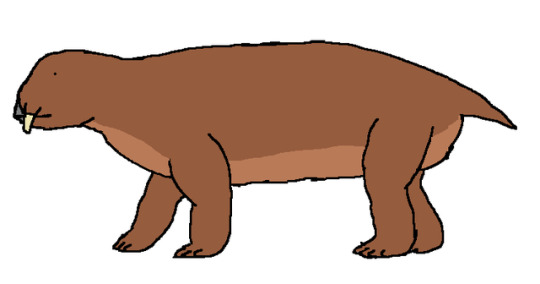
Lystrosaurus – Late Permian-Early Triassic (255-250 Ma)
I’m back! I was sort of at a loss of what animal to talk about when I came back from my hiatus in earnest, but during the spotty downtime I had last week, I read When Life Nearly Died by Michael Benton, and that pointed me in the direction of this chubby little gentleman, whose name is Lystrosaurus. Lystrosaurus is one of the (very very VERY) few animals to survive the Permian-Triassic Extinction event, and we’re gonna take a look at why exactly that is.
Lystrosaurus is yet another synapsid, or proto-mammal. This guy was a member of the second wave of Paleozoic synapsid radiation, a member of the order Therapsida, which were characterized by being more similar to true mammals than the first group, the pelycosaurs. Edaphosaurus and Cotylorhynchus were both pelycosaurs, and were a bit more basal. Lystrosaurus shows a few of those therapsid traits, most importantly the shape of its skull and its semi-sprawling gait. On the less mammalian side of things, it probably had a beak made of horn for shearing vegetation. It had the characteristic deep body cavity for digesting all the tough plants it ate. It also had no teeth except for a pair of enlarged canines, which it probably used to uproot its food. The most common species was about the size of a schnauzer, although a much rarer species grew a bit larger. All-in-all, it wasn’t really anything special compared to its contemporaries.
Despite being tiny and rather typical of an animal from its time period, Lystrosaurus is an important animal for a few reasons. Even though plate tectonics are common knowledge and accepted as fact now, it took a long time for it to gain any serious traction. Alfred Wegener was pretty much laughed off when he first suggested the continents move in 1915. As a part of this theory, Wegener also suggested the continents had been united at some point into a supercontinent he called Pangea. His contemporaries heard the idea and basically said, “Okay but continents don’t move, obviously. Have you ever seen a continent move?” To their credit, the evidence at the time was, more or less, Africa and South America fitting together and other such things. Which, yeah, we know were right now, but back then it wasn’t so obvious. The next several decades were a slow march to acceptance of the theory of continental drift. Lystrosaurus figures into this by having been found in Asia, Africa, Europe, and even Antarctica by the 70s. At that point, even the most hardened skeptics shrugged and said, “Okay, yeah, fine.”
Lystrosaurus is known from an absolutely stupid number of fossils. The Great Karoo Basin in South Africa has an unreasonable amount of Lystrosaurus remains. They make up 95% of the animals found there, and they’re so abundant that paleontologists pull their hair out trying to find literally anything else. The most studied parts of the Karoo Basin span the late Permian and Early Triassic, and once you get into the Triassic rocks, it’s pretty much Lystrosaurus all the way down. Why is that?
Because nothing else survived the Permian Extinction.
There are five major mass extinctions in the Phanerozoic Eon. I’ve talked about two of them on this blog so far. I talked about the End-Ordovician extinction event when I covered Endoceras, and the End-Triassic extinction with Effigia. And I’m here to say that those events were fucking peanuts compared to this one. This was the single greatest crisis for life on earth, to the point that it’s often called The Great Dying. This was the destruction of about 90% of all species on earth at the time, and for a while we weren’t even really sure what was causing everything to fucking die. The most accepted theory nowadays is the series of eruptions of the Siberian Traps at the end of the Permian period. Basically, most of what we now call Siberia turned into a volcanic wasteland and exploded every so often, anywhere from every few thousand years to every few months.
These were more than volcanic eruptions. This was fire and brimstone, magma punching massive holes in the earth and launching toxic gasses and solid ejecta into the atmosphere. Anything remotely nearby suffocated or was struck by fiery debris. This wasn’t the most severe killing agent, though, not at all. The Great Dying earned its name because of the secondary effects. The gasses spewing into the atmosphere blocked out the sun and caused flash-freezing, followed by periods of global warming. Glaciers melted and released even more toxic gasses trapped beneath them, poisoning the seas and killing anything unadapted to anoxic conditions. It’s pretty telling that the majority of the marine animals that survived into the early Triassic were clearly adapted to life without plentiful oxygen. Plants on land were suffocated or frozen to death, and the ecosystems collapsed from there. The earth was a frigid, barren landscape. The seas and land alike would be littered with corpses of animals and plants. The earth has mechanisms to balance these influxes of toxic chemicals, but the problem was that by the time those mechanisms could get started, Siberia would erupt again and start the process all over again. If you were to walk around Pangea during the peak of this crisis, 1) It would fucking suck, and 2) You’d probably come across a very distressed Lystrosaurus before finding any other animal.
Why in the goddamn hell did Lystrosaurus survive when so many other animals didn’t? It’s a complicated question, because it’s important to ask another question first: What animals are vulnerable to extinction events? There are a couple of broad categories of vulnerable animals during mass extinctions:
Large animals: Large animals are especially vulnerable because they need more energy to keep themselves going, and almost always have small populations and slow reproductive cycles. This goes for predator and prey alike. When plants start dying, herbivores can’t feed themselves, and the large carnivores that prey on them don’t have anything substantial to eat. This is the reason animals like elephants and rhinos have such a hard time bouncing back after we nearly hunted them all to extinction.
Specialized animals: Specialized animals are almost always doomed in big extinctions. If an animal is really, really good at functioning in a specific environment, it’s going to bite it as soon as that environment gets thrown off-kilter. Animals that specialize in eating a specific plant or hunting in a specific environment don’t usually survive when everything gets hit.
So, the animals who are most likely to survive a mass extinction are the small generalists, who can thrive pretty much anywhere. Lystrosaurus fits this description, but forget all of that for the purpose of this conversation, because the Great Dying decimated life of all sorts. Generalists were more or less just as likely to die off as the specialized animals or the big guys. So, we ask again, why did Lystrosaurus survive when so many other animals, even those similar to it, didn’t?
There isn’t really an answer to that question. Scientists have puzzled over the remains of Lystrosaurus and asked over and over again, “Why this little bastard?” and they’ve come up with nothing substantial. It was luck that a little beaked herbivore was one of the lucky few. There’s no adaptation that made it particularly hardy in the face of total metazoan annihilation. There’s no reason it survived the act break between the Paleozoic and Mesozoic eras. It just did because it happened to survive. This isn’t a parable of survival as much as it is one of dumb luck. One of the characteristics of a mass extinction is that it is essentially indiscriminate. Lystrosaurus had every reason to perish like its relatives, but it just didn’t. Being the generalist that it was, it wasn’t hard for it to recover when the Siberian Traps died down and life finally gained a foothold. It multiplied at an absurd rate and covered the earth. The early Triassic was unequivocally dominated by waddling herds of Lystrosaurus. An argument could be made that it’s the single most successful genus of synapsid in history, although Mus and Rattus would probably argue that point.
Whew. That was a lot. I hope it serves as a fitting return! Lystrosaurus was an animal I’d been meaning to cover for a long time, but only now felt like I was able to do it any justice. There’s so much to say about Lystrosaurus, to the point I could write a book about it. The cover would probably look something like this:
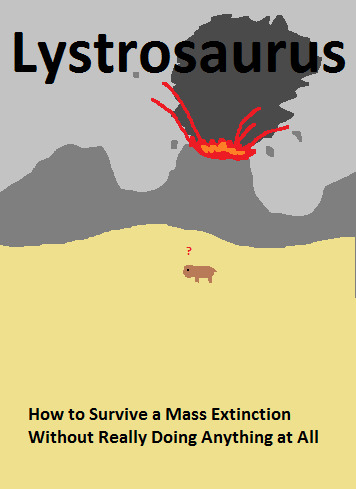
I’ll see you next time!
******************************************************************************
Buy me a Coffee, if you’d like!
#lystrosaurus#therapsids#synapsids#proto-mammals#permian#triassic#paleozoic#palaeozoic#mesozoic#paleoart#palaeoart#paleoblr#palaeoblr#paleontology#palaeontology#prehistoric
129 notes
·
View notes
Photo
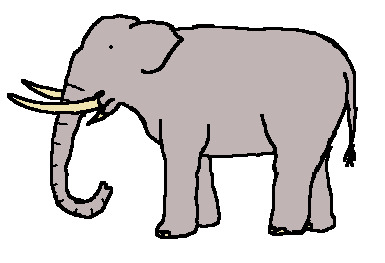
Primelephas — Late Miocene- Early Pliocene (7-2 Ma)
I love elephants. I came out of hiatus just to say that. They’ve always been one of my favorite animals, and prehistoric proboscideans were one of the first paleontology topics I was really interested in as a kid. That probably shows, considering this is the third one I’ve drawn for this blog. BUT, this is the first true elephant to be featured here, and fittingly enough, its name means “first elephant.” Let’s pretend I did that on purpose and didn’t realize it as I was typing this just now.
Primelephas is pretty mysterious, even though it only went extinct pretty recently. We know a lot about the Miocene/Pliocene as a whole, but we only have a few remains of Primelephas. Those few remains have been found in Africa, although it was probably more widespread than that. It packed the setup we’ve come to expect of an elephant: A long, grasping trunk that doubled as a bendy straw, big, sturdy legs, and a stocky body. We can pretty reasonably assume it was mostly hairless, too, considering the environment it lived in. It sounds an awful lot like a modern elephant, doesn’t it? The main difference is the pair of tusks on the tip of its jaw. Elephant tusks come in all shapes and sizes, so I tried to draw this one with a pair of upper tusks that properly show off the bottom pair.
Oh, also, Primelephas is the common ancestor of three genera of elephant: Mammuthus, Elephas, and Loxodonta. I mention this because those are, in order, the Woolly Mammoth, the Asian Elephant, and the African Elephant. That’s why it looks so much like a modern elephant, because it’s only one step removed. The best part about the Cenozoic is how well we understand the taxonomy of the animals who live in it. Not to mention, cats evolved during the Cenozoic, and I personally find that very important.
If you don’t know elephant taxonomy (and I don’t blame you if you don’t), you might find it weird that 1) African and Asian elephants are different genera, I didn’t know that until recently, and, 2) the Woolly Mammoth shares such a recent common ancestor with them. The other furry proboscideans, the Mastodons, diverged from their modern cousins during the Oligocene, around 30 million years ago, so it would make sense if mammoths did that, too. Except, they didn’t, because there are no rules in biology. Here’s a chart showing the family tree of modern elephants. Like the last time I did one of these, it’s very simplified and only shows the stuff that’s relevant.
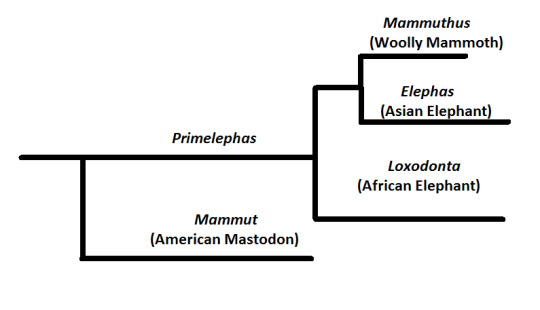
So, as you can see, mammoths are descended from Primelephas, just like modern elephants. Not only that, but mammoths are more closely-related to Asian elephants than Asian elephants are to African elephants. Considering mammoths evolved so recently from an ancestor who most likely only had sparse hair like a modern elephant, and considering just how close they are to Asian elephants, it’s very likely that heavier fur is a trait that’s relatively easy for natural selection to “turn on” or “turn off” in proboscideans. Also keep in mind this happened more than once, because Mastodons did it too. This is something we’ve studied pretty closely, and this is actually tapping on the window of a really cool subject that will have to be covered another day. For now, I have to crawl back into my hiatus cave and do some more research. I’ll see you all next week!
**********************************************************************************
Buy me a Coffee, if you’d like!
#primelephas#elephants#proboscideans#mammals#miocene#pliocene#cenozoic#paleoart#palaeoart#paleoblr#palaeoblr#paleontology#palaeontology#prehistoric
29 notes
·
View notes
Text
*Admin post* Pssssst
Hey everyone! You can now buy me a coffee, if you so desire!
I know this is pretty weird timing, dropping a link to a donation page two days into a hiatus, but I assure you, I’ll be posting regularly again next week! Donations would be very much appreciated, but I really want to stress that this is 45000000000% optional. If you can’t or don’t want to give anything, that’s okay! I appreciate your readership above everything else. I’m not about to do anything stupid like lock the blog behind a paywall or anything like that. So, give as you please, I will appreciate it! But if you don’t, no worries!
Also, stay tuned, I may or may not be cooking something up despite my busy schedule. I wouldn’t e-beg without sliding something your guys’ way ;D
17 notes
·
View notes
Text
*Admin post* I'm very busy
Hey everyone! My schedule is PACKED this week, so unfortunately this means updates will be slower. I'm going to try to make a post or two this week, but finding free time will be difficult. Things will go back to normal next week! I'm writing plenty of research down in the sporadic free time I do have!
6 notes
·
View notes
Photo
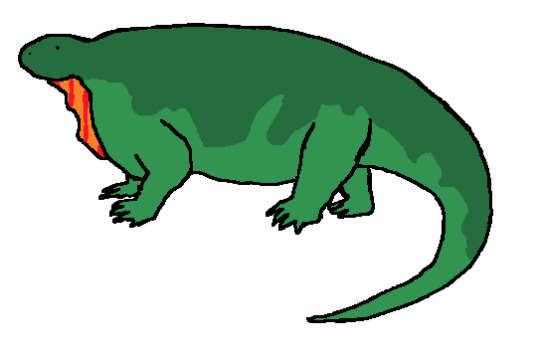
Cotylorhynchus – Early Permian (279-272 Ma)
Before the Mesozoic Era, millions of years before dinosaurs even thought about showing up, was a 50 million year-long period called the Permian. You probably know that already. The Permian was the first real boom in vertebrate diversity on land. Terrestrial vertebrates had come a long way during the Carboniferous, and made several important adaptations that helped them conquer the earth during the following period. Among them was the evolution of waterproof, hard shelled, or, “amniote,’ eggs. The ability to reproduce on land let vertebrates spread all over the continent of Pangea. This is especially helpful, because the Permian was drier than the Carboniferous.
Despite popular belief, the Permian wasn’t an age of reptiles. There were big reptiles, for sure, but they weren’t the majority. The majority was the other branch of amniotes, the synapsids. They were in charge, and had free rein to turn into all sorts of weird shapes. That’s how something like Cotylorhynchus happens.
This was the biggest guy around in the early Permian, which wasn’t as big as you might think. Think a cow that’s closer to the ground, and you have Cotylorhynchus. Oh, and shrink its head a bunch, too. Do you want to know why its head was so tiny? So do I.
Yeah, its head was just kind of like that. Its body was massive for a reason, though. Well, a few reasons. Like I mentioned a minute ago, Cotylorhynchus was a built motherfucker. It was significantly bigger than anything around it, even Dimetrodon, which was only about half its size without the sail. Cow-sized was enough to be absolutely massive back then, and its sheer bulk kept it safe. It also housed a powerful digestive system to break down plant matter. It was one of nature’s first examples of the walking glacier archetype, and it even reminds me of the Pokémon Avalugg, which is a literal walking glacier. And would you believe that the best way to beat both is to not even bother challenging their defense? Just set them on fire and they’ll both go down.
But really, Cotylorhynchus was essentially indestructible in the eyes of your average early Permian predator. It’s also worth mentioning that it had a cousin called Casea, which basically looked the same but was the size of an iguana. This begs the question, which came first, the big one, or the small one? Were they all tiny with tiny heads, or did they just shrink down to that size after a while? Cotylorhynchus and Casea lived at the same time, so it’s hard to say. We do know that there were members of their family who had reasonably-sized heads, on top of that.
Some other features worth mentioning: It had really broad shoulders and dexterous hands. It probably dug up roots and such as part of its diet. The shape of its skull implies it was really good at smelling, which is a good thing to be when you’re hungry all the time and constantly looking for food to nourish your colossal body. It also had long fingers and broad, paddle-like hands. Yes, I’m going there. From what we can tell about its range of motion and everything listed above, it was probably semi-aquatic. Yeah, it’s not really streamlined in any way whatsoever, but did it need to be? Manatees can get away with it. Cotylorhynchus probably swam more like a turtle, by drifting and propelling itself with its limbs. It wasn’t much more graceful underwater than it was on land, but it really didn’t have to be, if you ask me.
#cotylorhynchus#synapsids#proto-mammals#permian#paleozoic#palaeozoic#paleoart#palaeoart#paleoblr#palaeoblr#palaeontology#paleontology#prehistoric
67 notes
·
View notes
Photo
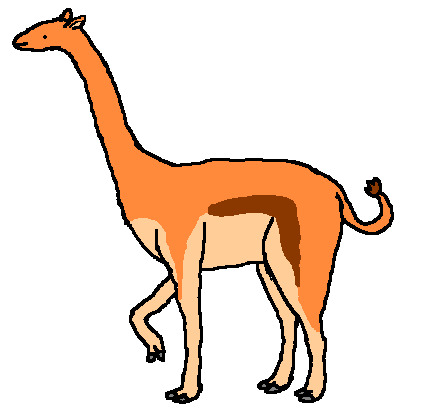
Aepycamelus – Miocene (20-4 Ma)
I kind of wish I was uploading this on a Tuesday, so I could call it Tallboy Tuesday, but no, it’s Monday. I’ll think of something, but in the meantime, it’s Aepycamelus. Aepycamelus pairs nicely with an elegant white wine, perhaps a chardonnay.
Aepycamelus is a camel who first shows up in the dawn of the Neogene period, and sticks around for most of it. It lived on the prairies of North America and was convergent with giraffes, of all things. Its long legs and neck were perfect for life on a grassland dotted with clusters of tall trees. Its remains are found all over North America, from Florida to California. It was a successful genus, with ten identified species. Older paleo fans might recognize it as Alticamelus, which is just a different name for the same animal. It’s similar to the Apatosaurus/Brontosaurus dichotomy.
Aepycamelus is a bit of a landmark form of fossil camelids. Camelids before it walked flat on their feet, but Aepycamelus has evolved the padded toes found on its modern cousins. It has the same stilt legs and general body plan, but it also has a lot of differences.
Today, we only know one genus of camel, Camelus. There are two species, C. dromedarius and C. bactrianus, the Dromedary and Bactrian camels. I’m a big fan of the Bactrian myself. They’re quite different, but have a lot of features in common. They’re desert dwellers with wide toes for walking on sand. They can go long periods of time without food or water, and store fat in humps on their back, which can see them through serious droughts and allow them to travel long-distance. Their stamina is something else.
Looking at evolution in hindsight, there’s only one genus of camel still around, and there aren’t many steps from there to the belief that camels were “evolving toward” the form of Camelus, that this is what a camel is supposed to be. The thing is, starting from the beginning of the camelid tree and working forward in time, you see that Camelus is a really weird genus of camel. It’s not the end goal or the standard for camels, but actually a highly-specialized form suited for living in deserts. Historically, camels looked much more like their cousins, the alpacas. Extinction is uncaring and unfeeling, and, for one reason or another, only the specialized forms of camel made it to this end of the Neogene-Quaternary boundary. It’s also worth mentioning that camelids evolved in North America before spreading to South America and Eurasia and going extinct on their continent of origin.
The history of camelids—and many modern groups—is replete with stories like this. There’s no shortage of twists and turns in the history of life, and camelids represent the concept pretty nicely. They’re a weird group with a handful of weird representatives in Eurasia and South America today. There are other mammals with similarly rich histories and only a few remaining survivors—hyraxes, sloths, and proboscideans being some of the most famous examples. But we’ll talk about them another day.
Aepycamelus is a nostalgic animal to me. I mentioned at the beginning of this writeup that they’re synonymous with Alticamelus, and that’s exactly how I first knew it. I read about it in a book from my grandparents called Prehistoric Monsters did the Strangest Things. Unfortunately, I couldn’t track down scans of the pages it’s on, but the book is pure, unadulterated classic dinosaur literature for kids. It’s super-outdated now, since it’s around 40 years old, but it’s full of charming art and it was one of my favorite books when I was a young paleo enthusiast.
Mega Camel Monday. That’s what today is called.
#aepycamelus#alticamelus#camels#mammals#miocene#neogene#cenozoic#paleoart#palaeoart#paleoblr#palaeoblr#paleontology#palaeontology#prehistoric
61 notes
·
View notes
Photo
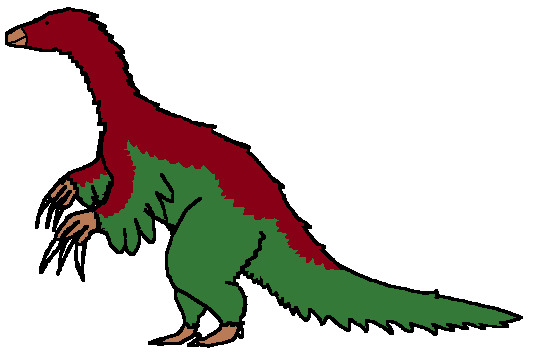
Nothronychus – Late Cretaceous (92-91 Ma)
This dinosaur is dumb. This dinosaur is SO dumb. It doesn’t sound like something that should be real, but it is. Its name is Nothronychus, and it’s a member of a group called therizinosaurs. They’re one of my favorite families of dinosaurs, but it took me so long to cover them because, honestly, I forgot something this bizarre existed.
This is a mid-sized member of its family from the western United States. That being said, it was 11 ft (3.4m) tall. Therizinosaurs were big. Nothronychus was an herbivore with a beak and blunt, leaf-shaped teeth. Its winglike arms may have been used to grasp tree branches, but we aren’t sure. The first Nothronychus bone to be found was part of the skull called the squamosal. This was originally thought to be a skull belonging to a primitive ceratopsian named Zuniceratops, but as more remains were discovered, we learned it was something much different, and much more recently understood.
Let’s talk about therizinosaurs as a group. They were some weird-ass dinosaurs. For starters, they’re herbivorous theropods. They’re part of the group called Coelurosaurs, which includes birds, dromaeosaurs, and tyrannosaurs. Like ceratopsians, they fist evolved in Asia and migrated to North America, probably across what we would today call the Bering Sea. Tens of millions of years later, our ancestors would reach North America using the same bridge. Therizinosaurs stood in that semi-upright, kangaroo-like stance we used to think all bipedal dinosaurs used. They were insulated by simple feathers, probably a mix of short, soft down and longer quills. Their most famous feature is their claws, which were used for… um, we don’t really know. Defense? Feeding? They had to be important somehow, considering how big they are.
Therizinosaur research has a long and convoluted history. Therizinosaurus, was originally described in 1954 as a turtle. Because the first name trumps all others, the sole species is still named Therizinosaurus cheloniformis (Turtle-shaped reaper lizard). Therizinosaurs were pretty much tucked away in a bin for the next 20-odd years until it was proposed that, hey, maybe we’re way off-base with this one and it’s actually a theropod. This idea was contested, as all new ideas in science are. Those of us who are less-inclined to believe in science point to this as evidence for science being dogmatic, but at the heart of every objection to a new theory is the simple question: “What’s your proof?” The proof was a little shaky back then, but it was suggested that therizinosaurs were theropods who were like big, prehistoric anteaters who used their claws to dig into insect mounds. It wasn’t until the decade was almost over that we finally found proof they were theropods, when a forelimb of Therizionsaurus was identified.
Despite that, we still kept finding therizinosaurs and thinking they were other things. Nanshiungosaurus was originally thought to be a sauropod, for example. Then, Segnosaurus was found, and interpreted as a fish-eater. A group of theropods was named after it, the segnosaurs. Although, then there was debate over whether or not they were actually sauropods, or maybe related to prosauropods. Their small heads and long necks were cited as evidence for that.
Thanks to computers and other big jumps in technology, paleontology advanced an awful lot in the 90s. We were suddenly able to set a lot of facts about extinct animals straight. We learned that just about every animal that would eventually be in this group was misidentified, and that ‘segnosaurs’ were actually just therizinosaurs, and that we had done kind of a bad job of recognizing them in the past. It wasn’t exactly expected that an entire oddball clade of dinosaurs was still out there waiting to be discovered. Paleontology can be fun like that.
Anyway, we now know they were big, weird herbivores with long claws for some reason. The two biggest, and honestly, most likely reasons, are for grasping branches and for defense. Nobody would want to fuck with an animal with giant scythe fingers, no matter how mild-mannered. We tend to think of herbivores as universally peaceful, but if you’ve ever seen that video of the jeep being chased by a giraffe, they’re that big for a reason. Hell, the most homicidal animals in Africa are hippos, because they’re just that fucking pissed all the time. If an herbivore has a weapon, it’s because it’s not afraid to use it.
Nothronychus is a relatively obscure animal. It appeared in a Discovery Channel special called When Dinosaurs Roamed America, where the main thing it did was slap a Dromaeosaurus and then die in a fire. Yeah. Pop culture representation for this group usually comes in the form of Therizinosaurus, which has shown up in a few places. It’s mentioned in Jurassic World as one of the animals whose DNA was used to create Indominus rex. It also shows up in ARK: Survival Evolved, where it has a short neck and a big head with no beak. The feathers aren’t exactly accurate either, but I don’t want to split too many hairs right now. It’s also apparently in the anime Dinosaur King, although I don’t know enough about that to elaborate.
#nothronychus#therizinosaurs#theropods#dinosaurs#cretaceous#mesozoic#paleoart#palaeoart#paleoblr#palaeoblr#paleontology#palaeontology#prehistoric
67 notes
·
View notes